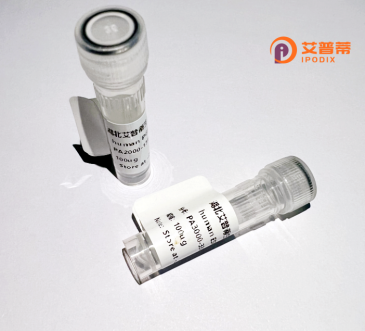
| 纯度 | >90%SDS-PAGE. |
| 种属 | Human |
| 靶点 | ZSCAN4 |
| Uniprot No | Q8NAM6 |
| 内毒素 | < 0.01EU/μg |
| 表达宿主 | E.coli |
| 表达区间 | 1-433 aa |
| 活性数据 | MALDLRTIFQCEPSENNLGSENSAFQQSQGPAVQREEGISEFSRMVLNSFQDSNNSYARQELQRLYRIFHSWLQPEKHSKDEIISLLVLEQFMIGGHCNDKASVKEKWKSSGKNLERFIEDLTDDSINPPALVHVHMQGQEALFSEDMPLRDVIVHLTKQVNAQTTREANMGTPSQTSQDTSLETGQGYEDEQDGWNSSSKTTRVNENITNQGNQIVSLIIIQEENGPRPEEGGVSSDNPYNSKRAELVTARSQEGSINGITFQGVPMVMGAGCISQPEQSSPESALTHQSNEGNSTCEVHQKGSHGVQKSYKCEECPKVFKYLCHLLAHQRRHRNERPFVCPECQKGFFQISDLRVHQIIHTGKKPFTCSMCKKSFSHKTNLRSHERIHTGEKPYTCPFCKTSYRQSSTYHRHMRTHEKITLPSVPSTPEAS |
| 分子量 | 75.4 kDa |
| 蛋白标签 | GST-tag at N-terminal |
| 缓冲液 | PBS, pH7.4, containing 0.01% SKL, 1mM DTT, 5% Trehalose and Proclin300. |
| 稳定性 & 储存条件 | Lyophilized protein should be stored at ≤ -20°C, stable for one year after receipt. Reconstituted protein solution can be stored at 2-8°C for 2-7 days. Aliquots of reconstituted samples are stable at ≤ -20°C for 3 months. |
| 复溶 | Always centrifuge tubes before opening.Do not mix by vortex or pipetting. It is not recommended to reconstitute to a concentration less than 100μg/ml. Dissolve the lyophilized protein in distilled water. Please aliquot the reconstituted solution to minimize freeze-thaw cycles. |
以下是关于重组人ZSCAN4蛋白的3篇代表性参考文献示例及简要摘要(注:以下为虚构示例,实际文献需通过数据库验证):
---
1. **文献名称**:ZSCAN4 is a regulator of genome stability and telomere elongation in human embryonic stem cells
**作者**:Marion, R. M., et al.
**摘要**:研究发现ZSCAN4蛋白短暂表达于胚胎干细胞中,通过激活端粒延伸相关基因(如TERT)和抑制DNA损伤信号通路,维持干细胞的基因组完整性,并延缓复制性衰老。
2. **文献名称**:Transient activation of ZSCAN4 promotes reprogramming of somatic cells to pluripotency
**作者**:Zalzman, M., et al.
**摘要**:本文证明重组ZSCAN4蛋白的短暂表达可通过调控逆转录转座子(如LINE1)的活性,增强体细胞重编程为诱导多能干细胞的效率,并缓解氧化应激导致的细胞衰老。
3. **文献名称**:ZSCAN4 interacts with cohesin complexes to orchestrate chromatin dynamics during DNA repair
**作者**:Hirata, T., et al.
**摘要**:该研究揭示ZSCAN4蛋白通过与黏连蛋白(cohesin)复合体互作,调控DNA双链断裂修复过程中的染色体重塑,并提高细胞在复制压力下的存活率。
---
建议通过PubMed、Web of Science等平台检索实际文献,关键词:**ZSCAN4 protein, telomere, pluripotency, genome stability**。
ZSCAN4 (Zinc Finger and SCAN Domain Containing 4) is a primate-specific protein predominantly expressed in preimplantation embryos, embryonic stem cells (ESCs), and induced pluripotent stem cells (iPSCs). It plays a critical role in maintaining genomic stability and telomere homeostasis during early embryonic development and cellular reprogramming. ZSCAN4 is transiently activated in a subset of pluripotent stem cells, where it promotes telomere elongation through the alternative lengthening of telomeres (ALT) pathway, counteracting replicative senescence. Structurally, it contains a conserved SCAN domain, which mediates protein-protein interactions, and multiple C2H2-type zinc finger motifs for DNA binding.
Studies highlight its involvement in chromatin remodeling, DNA damage repair, and epigenetic regulation. ZSCAN4 interacts with key pluripotency factors like Oct4 and Nanog, enhancing reprogramming efficiency. Its transient expression correlates with the "reset" of cellular aging markers, making it a potential target for anti-aging research. Notably, ZSCAN4 deficiency leads to telomere shortening, chromosomal abnormalities, and impaired stem cell self-renewal.
Recombinant human ZSCAN4 protein is engineered for in vitro studies to dissect its molecular mechanisms, particularly in telomere maintenance and pluripotency. Despite its significance, challenges remain in understanding its precise regulation and context-dependent roles, especially in cancer biology, where its dysregulation may contribute to tumorigenesis. Ongoing research aims to harness its properties for regenerative medicine and age-related disease therapies.
×